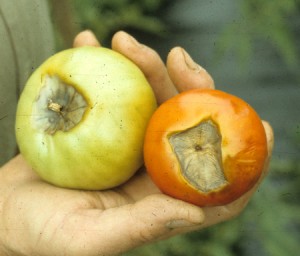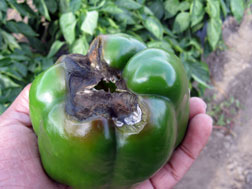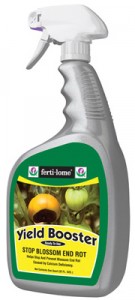Blossom End Rot
Blossom End Rot
This is the time of year when gardeners often find an ugly and discouraging symptom in their vegetable gardens… blossom end rot. It is most common in tomatoes, but is also frequently seen in peppers, eggplant, squash, and cucumbers.
 Blossom-end rot first appears as a water-soaked spot on the bottom of the fruit. The spot first turns brown and then black as fruit size increases. Blossom-end rot can appear on fruit in any stage of development, but it is most common when fruits are one-third to one-half grown. The first fruit produced by the plant are often most severely affected. Fruits that develop later in the season on the same plant might not be affected.
Blossom-end rot first appears as a water-soaked spot on the bottom of the fruit. The spot first turns brown and then black as fruit size increases. Blossom-end rot can appear on fruit in any stage of development, but it is most common when fruits are one-third to one-half grown. The first fruit produced by the plant are often most severely affected. Fruits that develop later in the season on the same plant might not be affected.
 So what causes it and how do you get rid of it? Well, once a fruit is infected it can’t be cured, but there are some things you can do to keep more fruit from becoming damaged. Prevention is the key.
So what causes it and how do you get rid of it? Well, once a fruit is infected it can’t be cured, but there are some things you can do to keep more fruit from becoming damaged. Prevention is the key.
Blossom end rot is actually caused by a calcium deficiency, which seems odd since we have an overabundance of calcium in most of our soils in east Idaho. But fluctuating soil moisture (drought and overwatering), excessive heat, root pruning during cultivation, and excessive nitrogen fertilizer applications can result in the plant being unable to translocate calcium from the soil to the fruit. Without it the plant cells in the fruit literally fall apart and leak, causing the blossom end of the tomato to shrivel and turn black. Tomatoes grown in pots, hanging baskets, or square foot gardens are especially at risk because the moisture levels in these can fluctuate so quickly. Keeping the root zone consistently moist is the key.
 Blossom-end rot can be minimized in several ways.
Blossom-end rot can be minimized in several ways.
1. Apply Epsom Salts (magnesium sulfate) to the soil at planting time. Use about 1 tablespoon per foot of plant height.
2. Maintain a uniform supply of moisture through regular watering and the use of mulches.
3. Don’t overdue the application of nitrogen. I like to use organic plant foods like Save-a-Tree, which are less likely to cause problems.
4. Avoid root injury by not cultivating within 1 foot of the base of the plant.
5. Apply foliar sprays of liquid calcium such as Fertilome Yield Booster. Apply weekly beginning when the plants first begin to set fruit, especially during hot weather.
The good news is that blossom end rot is not a disease, but a symptom of inadequate calcium, and its effects usually diminish as the season progresses. But it can be readily prevented by following the care tips above.


